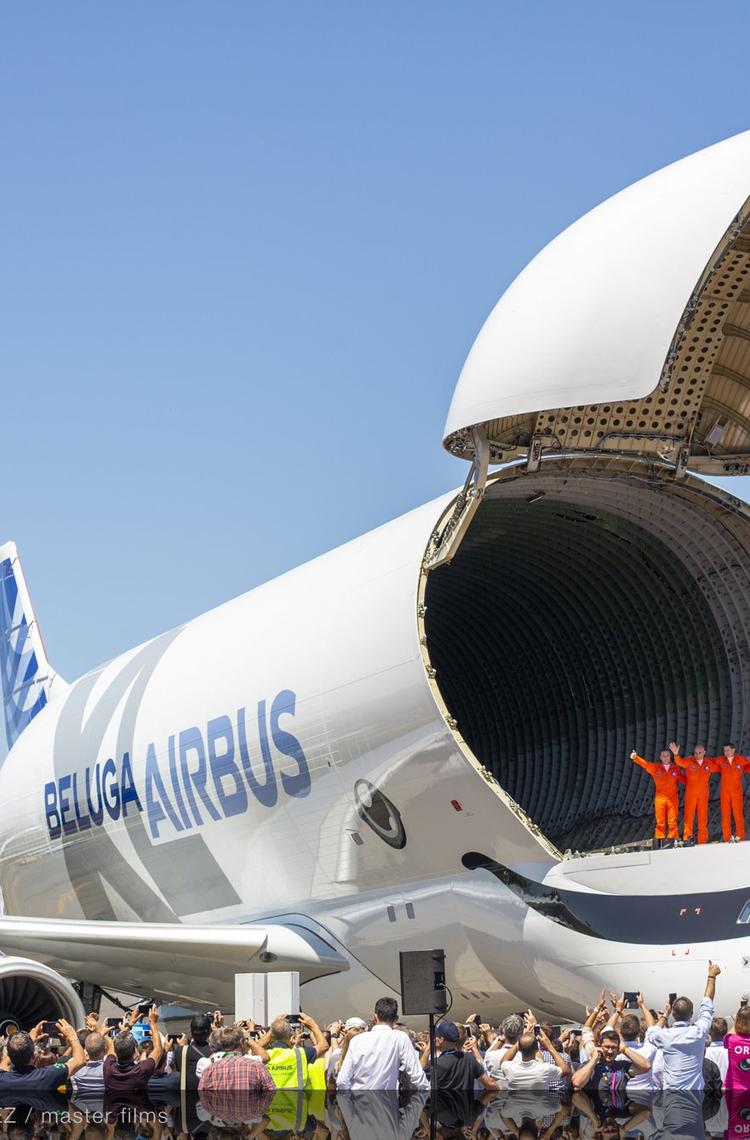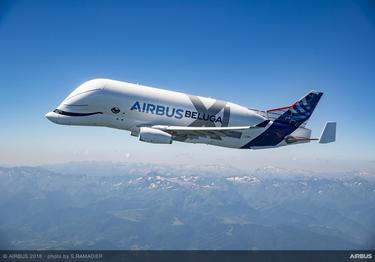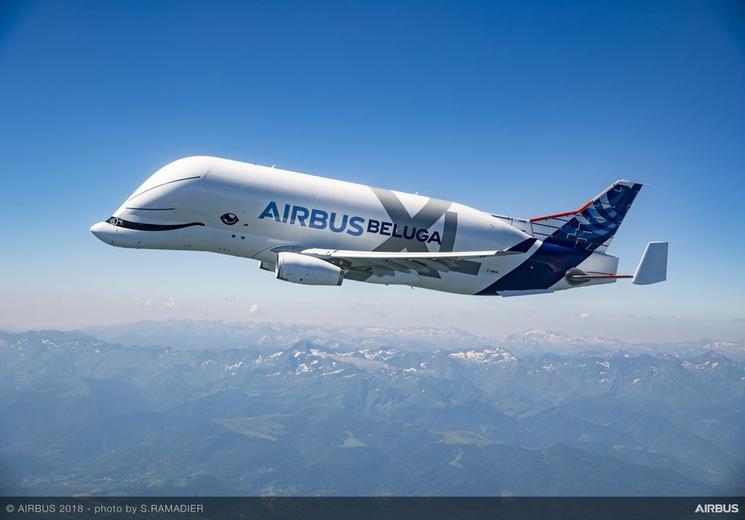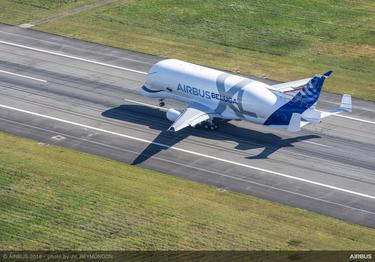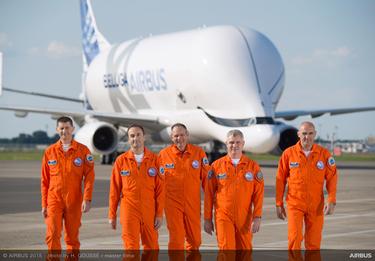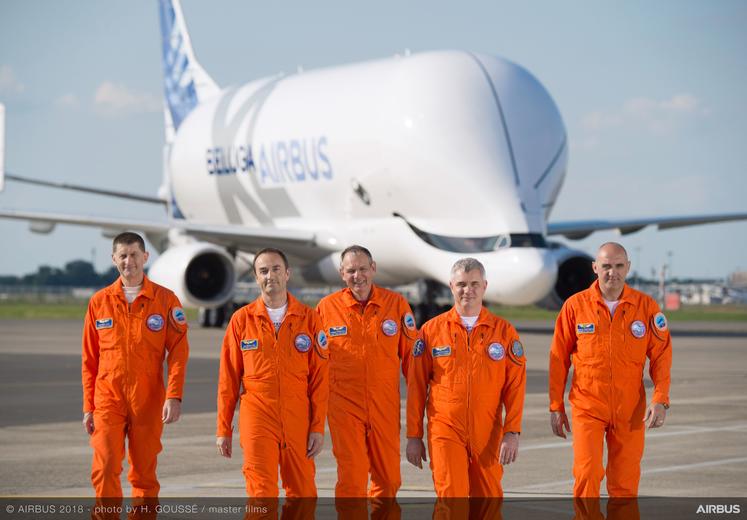The successful first flight of Airbus’ BelugaXL oversize airlifter marks an important milestone in further enhancing the company’s industrial network to support its production output – including the ramp-up in assembly rates for single-aisle and widebody commercial jetliners.
With an instantly recognisable livery – featuring a whale-type smile that was chosen by Airbus employees in a vote that attracted almost 21,000 participants – the no. 1 BelugaXL’s 19 July maiden takeoff initiated a 10-month, 750-flight hour certification campaign that will use two of the highly modified derivates of Airbus’ A330-200 freighter.
BelugaXL first flight takeoff
Airbus' no. 1 BelugaXL – whose livery features beluga whale-inspired eyes and an enthusiastic grin – accelerates down the runway at France’s Toulouse-Blagnac Airport before lifting off on its maiden flight, performed 19 July 2018
"The aircraft behaves really well in flight," said Christophe Cail, Airbus Chief Test Pilot and captain for the four-hour, 11-minute first flight from the company’s Toulouse, France headquarters site. "It's impressive how close the BelugaXL’s performance is to what we experienced in the ground-based flight simulators. First flights take a lot of preparation and we are just the tip of the iceberg, so ‘thank you’ to the entire team. It's only together that we can make it fly."
The aircraft behaves really well in flight. It's impressive how close the BelugaXL’s performance is to what we experienced in the ground-based flight simulators.
- Christophe Cail, Airbus Chief Test Pilot and captain
The BelugaXL has 30% more capacity than Airbus’ current Beluga ST airlifters.
Airbus' no. 1 BelugaXL – whose livery features beluga whale-inspired eyes and an enthusiastic grin – accelerates down the runway at France’s Toulouse-Blagnac Airport before lifting off on its maiden flight, performed 19 July 2018.
As the replacement for Airbus’ current BelugaST airlifters – which were derived from earlier-production A300-600 jetliners – the BelugaXL features a fuselage that is seven metres longer and an enlarged upper fuselage that is one metre wider.
BelugaXL’s greater size enables the new-generation airlifter to accommodate a set of A350 XWB wings, for example, speeding up their transport from the Broughton, UK production site to the programme's final assembly line in Toulouse. The aircraft also can carry the A350 XWB's largest fuselage section with room to spare. Additionally, the BelugaXL’s 30% extra capacity compared to the Beluga ST provides potential to meet ramp-up needs in meeting the global customer demand for Airbus single-aisle and widebody jetliners.
BelugaXL First Flight - Arrival
The BelugaXL’s maiden flight – which began and concluded at Toulouse-Blagnac Airport on 19 July 2018 – initiated a certification campaign that will lead to this next-generation oversize airlifter’s service entry in 2019
Once in service, the fleet of five BelugaXLs will replace the similar number of Beluga A300-600 ST airlifters operated by Airbus Transport International – Airbus' fully-owned oversize transport subsidiary. Each aircraft will perform between 900 and 1,000 flights per year, logging some 1,700 to 1,800 hours annually in servicing 11 line stations at locations across the company’s European industrial network.
The initial BelugaXL to enter operation in 2019 with Airbus Transport International will be the second-built aircraft, followed by two BelugaXLs during 2020, and one each in 2021 and 2022 – enabling the Beluga STs to be retired during the 2021-2023 timeframe.
The Airbus crew for BelugaXL’s first flight are (from left to right): Christophe Cail, Captain; Jean Michel Pin, Test Flight Engineer; Philippe Foucault, Flight Test Engineer; Laurent Lapierre, Flight Test Engineer; and Bernardo Saez-Benito Hernandez, First Officer.
BelugaXL by the numbers
The BelugaXL will gradually replace the existing five-member Beluga ST fleet – which is used for carrying complete sections of Airbus aircraft from different production sites around Europe to the final assembly lines in Toulouse, France and Hamburg, Germany. Learn more about Airbus’ next-generation oversize cargo aircraft with this special “animated infographic.”
